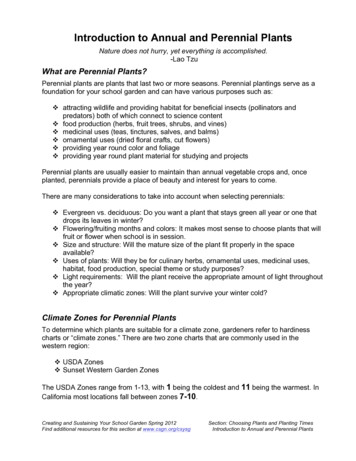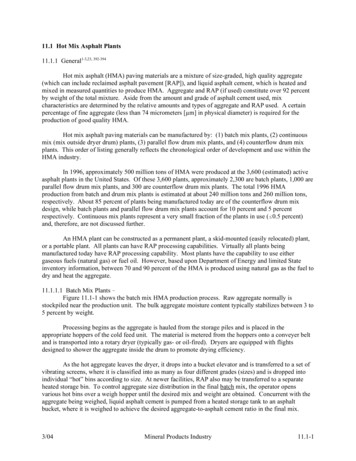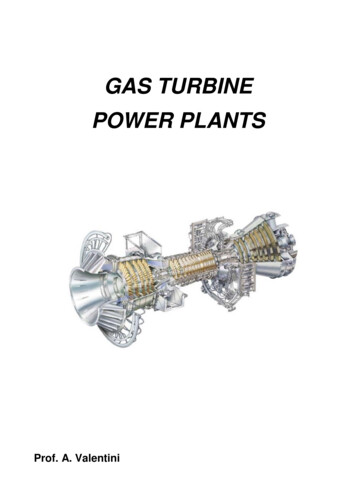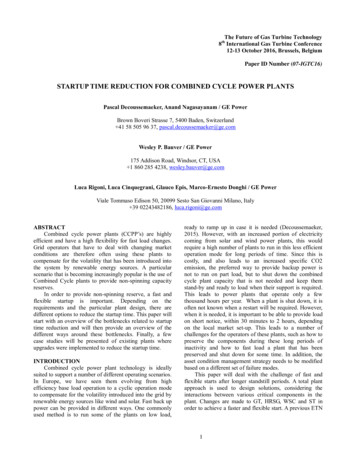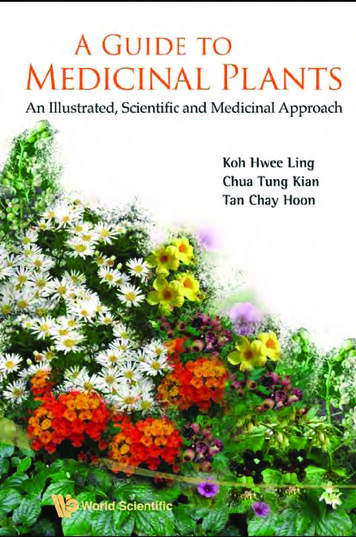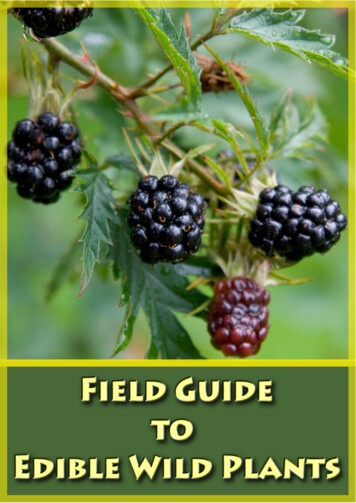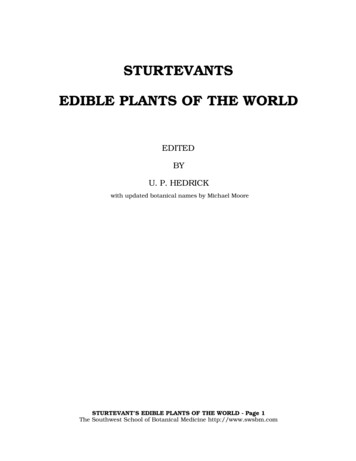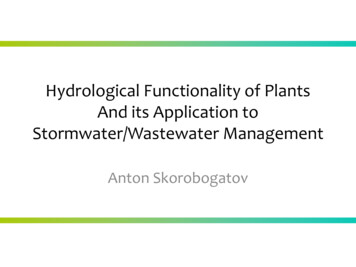
Transcription
Hydrological Functionality of PlantsAnd its Application toStormwater/Wastewater ManagementAnton Skorobogatov
Why Plants?o Plants are unique living organisms thatplay a pivotal role in our environmento Plants are abundant and diverse. Over90% of all visible living matter is plant lifeo Plantsdirectlyinfluencenaturalprocesses that are critical to life. Theseinclude the biogeochemical cycles ofwater, oxygen, carbon dioxide, andnutrientso Plants can have a pronounced impact onthe hydrological cycle both directly andthrough their impact on soil properties
Plant Hydrologyo There are three key aspects ofhydrology that are plant-related:1)1. Interception2. Infiltration3. Evapotranspiration2)3)
InfiltrationSoil Textureo Infiltration refers to water entering thesoil from the soil surfaceo Soil texture is usually utilized to predictinfiltrationSoil Structureo Engineered coarsely textured soils areassumed to have high hydraulicconductivityo Hydraulic conductivity of native soils isa function of soil structure and porosity
Soil Porosityo There are two defined types of poresthat exist in soils:o Micropores 3mmo Macropores 3-100 mmo Macropores make up 0.23 -2 % of totalsoil volume, yet can carry 74 -100% oftotal infiltration flowo Macropores can be formed by abioticprocesses, such as soil freezing/thawing, wetting/ drying,andcracking, or by living organisms
Plant Roots and Macropore Formationo All plants form soil macropores as their roots proliferateo Roots physically penetrate the soil, and radial expansion of the roots compactsthe soil in their immediate vicinityo Organic compounds are secreted from the plant roots into the surrounding soiland they bind soil particles togethero Woody species produce macropores of high resilience due to the lignin liningo Plant roots transform the soil from a collection of particles into a network ofstable channels, capable of carrying water to greater depths of soil profile
Plant Growth and Soil Hydraulic Conductivityo A plant-induced increase in soil hydraulic conductivity has been demonstratedby agricultural studiesAngers and Caron 1998
The Effect of Woody Species on Soil Hydraulic Conductivityo Isolated anthropogenic woody vegetation plantings set within uniform soil andtopography - shelterbelts, tree beds in urban parks, tree rows in urban golf courseso Measure saturated soil hydraulic conductivity with Guelph Hydraulic Permeameterwithin the planting and compare it to the surrounding area
Guelph Hydraulic Permeametero Measures saturated soil hydraulicconductivityo Constant level of water is maintained in thewell by the vacuum inside the reservoiro The steady-state discharge rate refers tothe intrinsic properties of the soil and isindependent of pre-existing soil moistureo Less impacted by capillary forces thanconventional ring infiltrometero More mobile and less invasive than doublering infiltrometer
Alberta Shelterbelt Nursery, BowdenN 1
Glenmore Park Tree Beds, Calgary
Woody Vegetation and Soil Hydraulic ConductivitySaturated Hydraulic Conductivity,mm/hr12010080tree stand60controlN 340200willowpoplarlarchspruce
Plant physiologyo Root physiology dictates the nature ofmacropores that get formed by the planto Grass roots are not capable of significant radialexpansion, which would compact thesurrounding soilo Roots of woody plants have an additional layerof complex organic polymer surrounding theroot and making the resulting macropore moreresiliento Deciduous woody species have short-livedroots, which would facilitate abundantmacroporesPlant speciesRoot longevity (years)Malus sp.0.02 - 0.04, 0.2 – 0.26Tsuga sp.3.5Pinus sp.4Prairie4data from Waisel et al 1996
EvapotranspirationSpecieso Deciduous species tend to have greatertranspiration rates per leaf unit areaTranspiration rate(mm/day)Hybrid Poplar2.3 -3.5Cottonwood/willow4.8o Intrinsictranspirationratesareproportional to leaf conductance ratesNorway spruce0.90- 0.97o Leaf conductance rates are proportionalto stomatal conductance ratesSpeciesdata from Chang 2006Transpiration rate(g/day/m2)Northern Red Oak1245Yellow Poplar976Loblolly Pine508data from Kramer and Kozlowski 2006
Evapotranspirationo Plant water loss is usually restricted tostomata of plant leaveso Stomata usually occupy 1% of leaf area,yet stomatal diffusion may be as high as50% of open water evaporationo The size and number of stomatal openingsdetermines hydraulic functionality of aparticular plant
Evapotranspirationo Evapotranspiration refers to all the processes that transfer water from land to theatmosphereo Water balance (Run-off, Precipitation, Storage)o Energy balance (heat fluxes and radiation)o Penman equation (Daily T, wind speed, humidity, and solar radiation)o Refined by Monteith to include plant-specific parametersLand coverMaximum leaf conductance,(mm/s)Conifer forest5.3Broadleaf forest5.3Grassland8Tundra/non-forest wetland 6.6Typical crop11Leaf area index66343Vegetation height, (m)25250.50.30.3data from Federer et al 1996
Rough Estimates based on available dataoTranspiration rates for some plants are knownSpeciesooooUsing the LAI and Vegetation height as perland cover typeUse variation in leaf conductance to compareintrinsic evapotranspiration efficiency ofdifferent plantsLeaf conductance is highly dependent onstomatal pore indexCan use ratio of stomatal pore index of a plantwith known transpiration rate to calculate acoefficient to estimate transpiration rates ofother plantsTranspiration rate(mm/day)Hybrid Poplar2.3 -3.5Cottonwood/willow4.8Norway spruce0.90- 0.97data from Chang 2006Land coverConifer forestBroadleaf forestGrasslandTundra/non-forestwetlandTypical cropLeaf areaindex6634Vegetationheight, (m)25250.50.330.3data from Federer et al 1996
Stomatal Pore Index Variation0.50.45Stomatal Pore Index0.40.350.30.250.20.150.10.050data from Sack et al 2003
Plant Hydraulic Conductanceo Hydraulic conductance of plants is linkedto their leaf conductanceo Another limitation may come from stemand root conductanceo Ultimately, plants that are highlyconductive to water have greatertranspiration rateso Selecting plants with higher transpirationrates can allow to remove more waterfaster
Absorptive Landscapingo Man-made systems that rely on naturalprocesses to manage watero One of the main goals is to minimizesurface run-off (Q)o This goal is achieved by maximizinginfiltration (I) and evapotranspiration(ET)o Depressions containing highly permeablesoils and vegetation – rain gardens,bioswales, bio-retention systems
Sediment Accumulationo Maximizing infiltration is achieved by utilizing coarsely grained mediao Over time fine particles originating from stormwater run-off accumulate on thesurface of coarsely-grained filter mediao Resultant surface sealing prevens water from entering the soil and leading to anoverall decrease in hydraulic conductivity, infiltration rate and overall systemfunctionalityInitial PerformanceLong-term Performance
Plants to the Rescueo Maximizing infiltration is achieved by utilizing plants that produce abundant andresilient macroporeso Over time fine particles originating from stormwater are incorporated into themedia without sealing the surfaceo Large woody plants appear to be more effective than small shrubs, forbs, or grassesType ofVegetationKin (4 weeks), Kfinal (60 icroleana15049Leucophyta23166Melaleuca155295data from Coustumer et al 2012
Water Qualityo Plants are also capable of nutrient uptakeo Vegetated treatments each had: Banksia – a shrub/tree, Bottlebrush – a shrub/tree,Flax Lily – a tufted small lily, Swamp Foxtail Grass – a tufted grass, 3 yrs oldo Best performance is seen when plant action is combined with finely grained soilsParameterAnnual Loadkg/ ha yrTotal Phosphorous1012Nitrogen Oxides639Total Nitrogen1073Media en retention Vegetated retentionkg/ ha yrkg/ha 5197816data from Lucas and Greenway 2008
Conclusionso Vegetative proliferation improves soil structure and increases soil hydraulicconductivityo Woody species have a significantly greater impact on soil permeability ascompared with herbaceous lawn grasseso Plants posses various hydraulic functionalities, and some are better at increasingsoil hydraulic conductivity, as well as utilizing soil watero Plants can have a pronounced impact on nutrient removalo Plants are low-maintenance living instruments that should be utilized to managewater quantity and quality as well
Thank You!o Questions?o Key referencesooooooAngers D.A., Caron, J., 1998. Plant induced changes in soil structure: processes and feedbacks. Biogeochemistry,42, 55-72.Chang, M., 2006. Forest Hydrology: An introduction to water and forests. Boca Raton, FL: CRC Press.Federer, C.A., Vorosmarty, C., Fekete, B., 1996. Intercomparison of methods for calculating evaporation in regionaland global water balance models. Water Resources Research, 32 (7), 2315-2321.Le Coustumer, S., Fletcher, T.D., Deletic, A., Barraud, S., Poelsma, P., 2012. The influence of design parameters onclogging of stormwater biofilters: a large-scale column study. Water Research, 46, 6743-6752.Lucas, W.C., Greenway, M., 2008. Nutrient retention in vegetated and non-vegetated bioretention mesocosms.Journal of Irrigation and Drainage Engineering, 134, 613-623Waisel, Y., Eshel, A., Kafkafi, U., 1996. Plant roots: the hidden half. New York, NY: Marcel Dekker, Inc.www.source2source.ca
compared with herbaceous lawn grasses o Plants posses various hydraulic functionalities, and some are better at increasing soil hydraulic conductivity, as well as utilizing soil water o Plants can have a pronounced impact on nutrient removal o Plants are low-maintenance living instruments that should be utilized to manage water quantity and quality as well . Thank You! o Questions? o Key .



